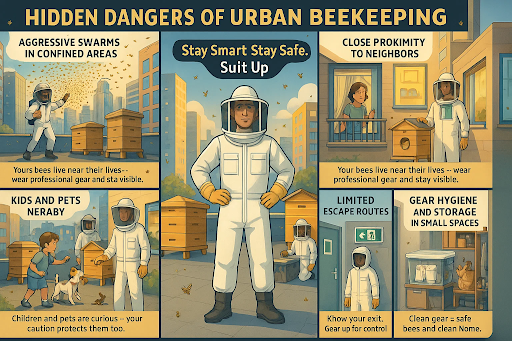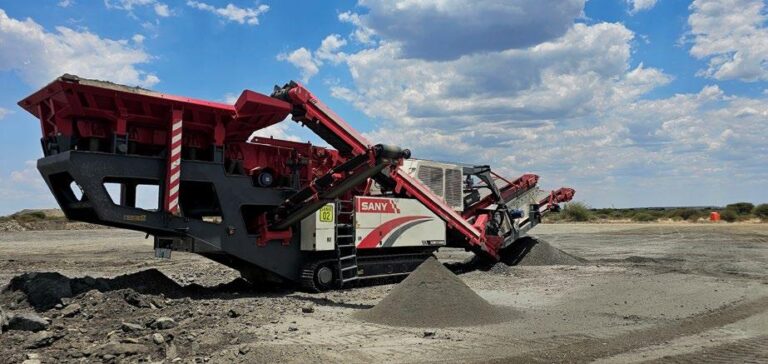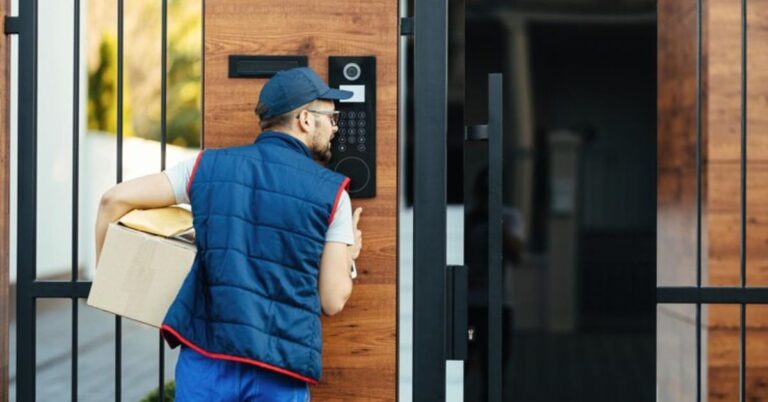The Hidden Dangers of Urban Beekeeping (and How to Stay Safe)

Urban hives come with unique risks — and they demand smart strategy, awareness, and proper beekeeping protective clothing.
Urban beekeeping has taken off like never before. From Brooklyn rooftops to Los Angeles balconies, more and more people are turning their urban spaces into buzzing sanctuaries. It’s eco-friendly, therapeutic, and helps boost declining bee populations. Sounds perfect, right?
But behind this charming trend lies a set of hidden dangers — especially for beginners or those unaware of how different the urban landscape is from rural or farm-based beekeeping.
Unlike countryside beekeepers, urban beekeepers share space with tight neighborhoods, kids playing in nearby yards, aggressive city swarms, and unpredictable weather patterns between buildings. And if you’re not prepared — especially without the right beekeeping protective clothing — you could be putting yourself and others at risk.
Let’s break down the real challenges of urban beekeeping, and how you can stay protected, responsible, and sting-free.
🚨 1. Aggressive Swarms in Confined Areas
In urban spaces, bees are often placed on rooftops, balconies, or tiny backyard plots — areas where flight paths are limited and air circulation is different. When bees feel crowded or disrupted, they are more likely to become defensive or swarmy.
Now imagine an angry swarm taking off… just a few feet away from your neighbor’s toddler pool or a crowded apartment window.
Why this happens:
- Urban vibrations (like traffic, loud construction, or city sirens) can trigger agitation
- Limited floral sources can lead to competition and hive stress
- Overheating in metal-roofed buildings or sun traps makes bees restless and defensive
How to protect yourself:
Always wear full beekeeping protective clothing — including a triple-layer ventilated suit, gloves, and a secured veil. Urban hives require regular checks and stress management, and the right gear ensures you can work safely, even when bees are having a bad day.
🚧 2. Close Proximity to Neighbors
One of the biggest risks in urban beekeeping isn’t the bees — it’s the humans nearby. Your bees may be gentle with you, but to someone allergic, scared, or simply uninformed, even a single bee can feel like a threat.
Real concerns:
- Bees accidentally entering neighboring apartments or cars
- Neighbors calling pest control if they see frequent swarms
- Accusations after a sting, even if your bees weren’t responsible
Prevention tips:
- Always communicate with neighbors before setting up a hive
- Keep bees’ flight paths high by placing water sources and plants above eye level
- Wear clearly visible beekeeping protective clothing during inspections — this shows professionalism, reduces panic, and makes you appear responsible (not careless)
Wearing gear that covers you head-to-toe also prevents bees from transferring to your clothes and flying off into someone else’s yard.
🧒 3. Kids and Pets Nearby
Urban living means shared fences, tight spaces, and often curious kids and pets nearby. While a country hive might have acres of buffer space, city hives are often just feet away from where children play or dogs run.
Why this is dangerous:
- Kids may try to “touch the bees” out of curiosity
- Dogs and cats might dig near hive stands or chase returning foragers
- Bees may sting if startled suddenly by loud noises or erratic movement
Smart strategy:
Install bee-friendly fencing or hedges that guide bee traffic upward and away from walkways. And never perform inspections without full beekeeping protective clothing, even if you think the hive is calm. This is especially important if you’re working in view of kids or others — lead by safe example.
🌆 4. Heat Islands and Building Radiation
Cities tend to trap heat. Rooftops, concrete, glass reflections — all of it contributes to urban “heat islands.” And guess what? Your bees feel it too.
Urban-specific problems:
- Hives overheat faster
- Bees become dehydrated and irritable
- Beekeepers themselves can suffer heat exhaustion in traditional suits
The solution:
Invest in ventilated, breathable beekeeping protective clothing specifically made for hot environments. Triple-vent suits with airflow mesh keep you cool and safe during rooftop inspections or mid-day heat checks. Avoid plastic-like or thick canvas suits that trap heat and sweat — they’ll only shorten your inspection time and increase risk.
🛠️ 5. Limited Escape Routes (For You and the Bees)
When a hive gets defensive in an open field, you can walk away. In a city, that’s harder. You might be on a 4th-floor rooftop, cornered on a balcony, or surrounded by parked cars — not ideal when bees are chasing.
Why it matters:
- You might panic without a safe exit
- Bees might follow you into stairwells or indoor spaces
- Removing the veil mid-inspection becomes dangerous
What to do:
Plan your escape route before you open the hive. Always inform someone nearby that you’re working with bees. And above all, wear secure, full-coverage protective gear — from boots to veil — so that if things get heated, you’re protected enough to calmly pack up and retreat.
Modern beekeeping protective clothing is lightweight and secure enough to keep you safe even during unexpected swarms — and gives you time to think, not panic.
🧼 6. Gear Hygiene and Storage in Small Spaces
Urban dwellers often live in apartments or shared buildings — which makes cleaning and storing bee suits tricky. A sweaty suit sitting in your closet can grow mold. A dirty glove thrown on a balcony can attract pests.
What can go wrong:
- Mold or bacteria builds up in suit fabric
- Suit carries pheromones from angry hives into the next inspection
- You forget to zip a pocket and find a bee inside the next morning!
Simple solution:
Choose beekeeping protective clothing made with washable, quick-dry material. Suits with detachable veils and gloves are easier to clean and air out. Store your gear in a sealed container or designated bee box away from daily items or clothing.
💡 Final Thoughts: Urban Beekeeping Isn’t Easy — But It Can Be Safe
Beekeeping in the city has its charm, but it also demands awareness, discipline, and the right gear. Unlike rural setups, where nature provides space and silence, urban beekeepers need to actively create safety — for themselves, their bees, and the people around them.
The number one rule? Don’t underestimate the importance of protection.
Wearing high-quality beekeeping protective clothing is not just a best practice — it’s the only way to truly manage an urban hive responsibly.
From ventilated suits to anti-sting gloves and secure veils, investing in the right gear means:
- Fewer stings
- Fewer neighbor complaints
- More confident inspections
- And happier, healthier hives
So suit up, stay smart, and let your city buzz safely with life.






